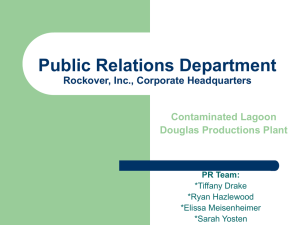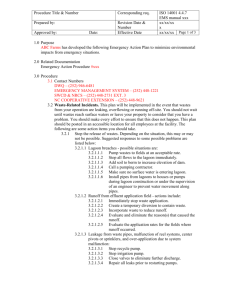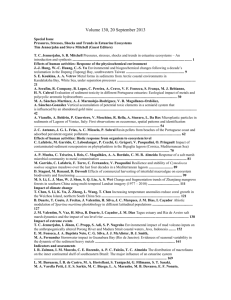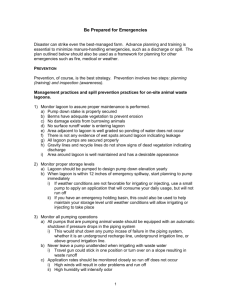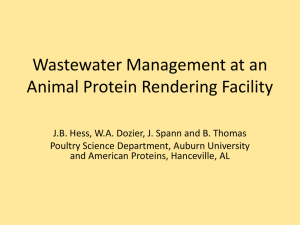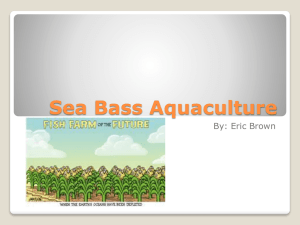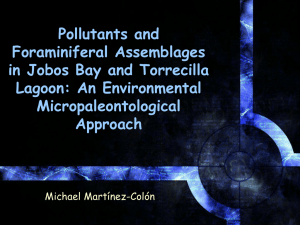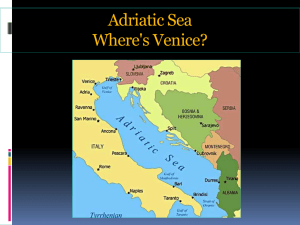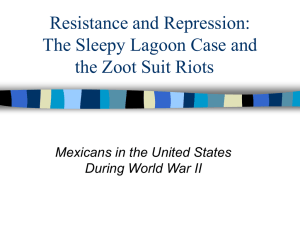505-086
advertisement
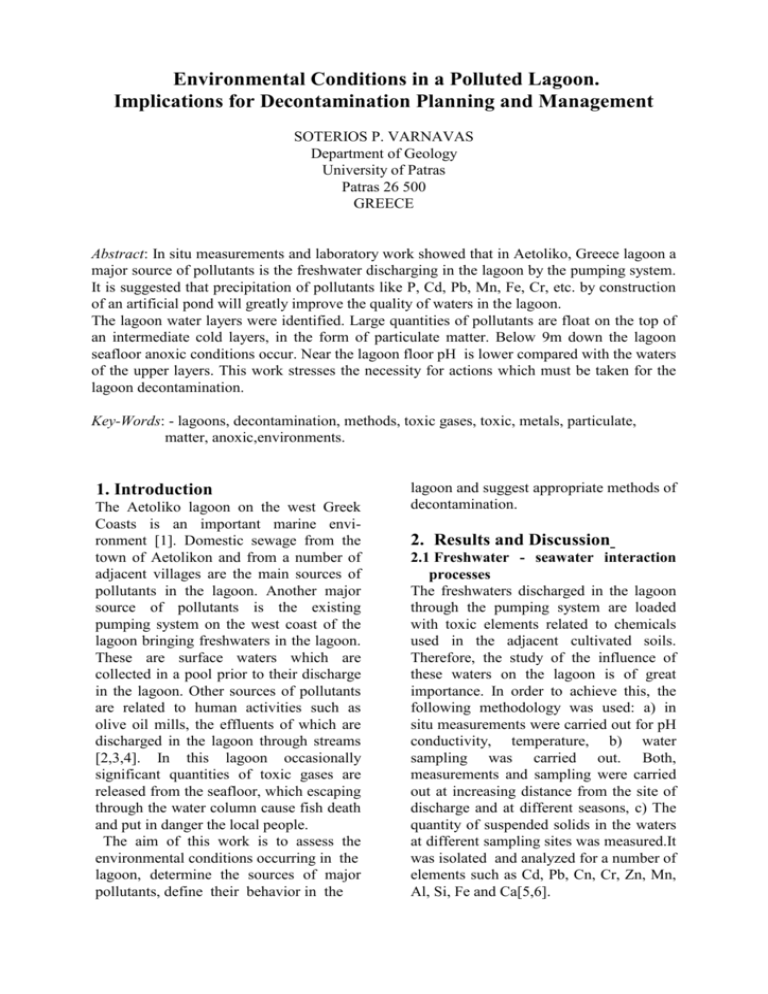
Environmental Conditions in a Polluted Lagoon. Implications for Decontamination Planning and Management SOTERIOS P. VARNAVAS Department of Geology University of Patras Patras 26 500 GREECE Abstract: In situ measurements and laboratory work showed that in Aetoliko, Greece lagoon a major source of pollutants is the freshwater discharging in the lagoon by the pumping system. It is suggested that precipitation of pollutants like P, Cd, Pb, Mn, Fe, Cr, etc. by construction of an artificial pond will greatly improve the quality of waters in the lagoon. The lagoon water layers were identified. Large quantities of pollutants are float on the top of an intermediate cold layers, in the form of particulate matter. Below 9m down the lagoon seafloor anoxic conditions occur. Near the lagoon floor pH is lower compared with the waters of the upper layers. This work stresses the necessity for actions which must be taken for the lagoon decontamination. Key-Words: - lagoons, decontamination, methods, toxic gases, toxic, metals, particulate, matter, anoxic,environments. 1. Introduction The Aetoliko lagoon on the west Greek Coasts is an important marine environment [1]. Domestic sewage from the town of Aetolikon and from a number of adjacent villages are the main sources of pollutants in the lagoon. Another major source of pollutants is the existing pumping system on the west coast of the lagoon bringing freshwaters in the lagoon. These are surface waters which are collected in a pool prior to their discharge in the lagoon. Other sources of pollutants are related to human activities such as olive oil mills, the effluents of which are discharged in the lagoon through streams [2,3,4]. In this lagoon occasionally significant quantities of toxic gases are released from the seafloor, which escaping through the water column cause fish death and put in danger the local people. The aim of this work is to assess the environmental conditions occurring in the lagoon, determine the sources of major pollutants, define their behavior in the lagoon and suggest appropriate methods of decontamination. 2. Results and Discussion 2.1 Freshwater - seawater interaction processes The freshwaters discharged in the lagoon through the pumping system are loaded with toxic elements related to chemicals used in the adjacent cultivated soils. Therefore, the study of the influence of these waters on the lagoon is of great importance. In order to achieve this, the following methodology was used: a) in situ measurements were carried out for pH conductivity, temperature, b) water sampling was carried out. Both, measurements and sampling were carried out at increasing distance from the site of discharge and at different seasons, c) The quantity of suspended solids in the waters at different sampling sites was measured.It was isolated and analyzed for a number of elements such as Cd, Pb, Cn, Cr, Zn, Mn, Al, Si, Fe and Ca[5,6]. An investigation of the fresh water seawater interaction processes showed that at the transition from the freshwater to the seawater with slight increase of the salinity there is a sudden increase in the phosphorus value. This phenomenon was observed in December, January and May. Under the same conditions there is a tendency for metals to increase in the particulate matter. This is a result of in crease of the degree of transfer of the ions from the dissolved to the solid form. The degree of incorporation of the metals studied in the solid form decreases in the following order: Mn>Zn>Cu>Cd>Fe. These are useful observations which can be used in planning the decontamination of the lagoon. Figure 1 shows the vertical variability of temperature at the deeper zone of the lagoon on 19.3.2005. It is seen that temperature decreases from the seasurface down to 8 m depth, the rate of decrease in creasing at 5m. At 8m temperature reaches its lowest value, remaining constant down to 14m. At 15m there is a sudden increase in the temperature. Below this depth temperature tends to increase, with a change in rate at 19m. 2.2.2 Conductivity The conductivity profile shows a distinct peak at 8m, (Figure 2.).Below this depth, changes in the rate of coductivity were observed at 14m and 19m Station 4 19/3/05 Station 4 19/3/05 Conductivity ( mS/cm ) 23 24 25 26 27 28 29 30 31 32 33 34 23,524,525,526,527,528,529,530,531,532,533,534,535 Depth ( m ) 2.2. Water masses. In order to define the existing water masses in the lagoon temperature and conductivity measurements at increasing water depth were carried out with an AANDERAA RCM9 Recording Current Meter. Therefore, it is feasible with this method to locate thin water layers. 0 2 4 6 8 10 12 14 16 18 20 22 24 26 28 Temperature (o C ) 9 10 11 12 13 14 15 16 17 18 0 2 Fig. 2: Vertical variability of conductivity (19/3/05) 4 6 21/6/1999 8 Depth ( m ) 10 12 Conductivity ( mS/cm ) 14 15 17 19 21 23 25 27 29 31 33 35 37 16 18 22 24 26 28 Fig.1: Vertical variability of temperature (19/3/05) 2.2.1 Temperature depth ( m ) 20 0 2 4 6 8 10 12 14 16 18 20 22 24 26 28 30 Fig. 3: Vertical variability of conductivity (21/6/99) Station E9 D. O. (mg/l) 0 1 2 3 4 0 2 4 Depth (m) On the basis of the temperature and conductivity vertical variations the following water masses were defined: i) a surface layer (0-4m) ii) 6-6m iii) 6-8m iv) 8-14m v) 14-19m vi) 19m - seafloor. It is interesting to note that the sharp conductivity peak at 8m depth coincides with the ceiling of the cold layer (8-14m), peaks of suspended particulate matter, particulate Fe, Cr, Zn concentrations. It is therefore implied that large quantities of contaminants are float in form of a thin layer above the cold layer, floating in the lagoon. It is considered that this knowledge is of importance in decision making plans for decontamination and management of the lagoon. Similar peaks in particulate Fe, Cr, Zn were located at 4m depth, which coincide with a change in the rate of temperature decrease, and in the seafloor waters with the highest conductivity value. 6 8 10 12 14 16 Fig. 5: Vertical variability of dissolved oxygen (21/6/99) 2.2.4 pH Significant decrease in pH values were observed in the waters near the seafloor compared with the upper part of the water column. 2.2.3 Dissolve doxygen (D.O.) Dissolved oxygen measurements were carried out in the hot period (June) in the deeper zone of the lagoon which showed that D.O. decreases from the seasurface down to 8m depth (ceiling of the cold layer). Just below this depth (8.5m) D.O. is below 1 mg/l, while below 9m down to the seafloor D.O. is zero. 21/6/99 pH Depth ( m ) 7 Station E5 D.O. (mg/l) 0 1 2 3 4 5 7,5 8 8,5 0 2 4 6 8 10 12 14 16 18 20 22 24 26 28 30 0 1 2 Depth (m) 3 Fig. 6: Vertical variability of pH (21/6/99) 4 5 6 7 8 9 Fig. 4: Vertical variability of dissolved oxygen (21/6/99) 3 Metal concentration variations in the water column Particulate matter analyzed from different water levels in the lagoon showed the following: i) the particulate matter shows increase in the bottom waters, near the surface and in the intermediate water masses. ii) Particulate Fe, Cr, Zn, show significant peaks at 4m, 9m, depth and near the seafloor. iii) Pb, Mn show similar vertical variability with the above group of metals, except that the 9m peak is very weak. iv) Cr shows a tendency to decrease with depth down to 20 m depth with very slight increase at 9m depth. It exhibits a very pronounced peak near the bottom. 4 Conclusions In situ measurements and laboratory work allowed the determination of the existing environmental conditions in the Aetoliko lagoon, which are of importance in planning its decontamination and management. A major source of contaminants is the fresh water discharged in the lagoon by the pumping system. The study of the behavior of these contaminants, mainly phosphorous and toxic metals (i.e Pb, Cd, Cr et.) suggests that removal of these contaminants will greatly improve the quality of the freshwater and in turn of the lagoon. The removal of the contaminants can be achieved by planning and construction of an artificial pond for this purpose. It has been revealed that at intermediate water depths there is a cold layer at the top of which pollutants (i.e Cd, Pb, Cr, Mn etc) float in the form of particulate matter. Similar layer rich in pollutants also exists in shallow layers and near the seafloor. These are characterized by sharp peaks in conductivity. The deep waters, where release of toxic gases takes place, are characterized by low pH relative to the waters of the upper part of the column. Further geochemical study is needed prior to take any action for improving the quality of the seafloor environment[7,8]. Below 9m depth dissolved oxygen reaches zero value down the seafloor (32m). It is therefore revealed that a large part of the water masses in the lagoon are under anoxic conditions. It should be stressed that actions must be taken for decontamination of the lagoon for the following reasons: i) The lagoon is a food source environment; fishing of large quantities of fish throughout the year takes place. ii) Although it is not known whether toxic metals get into the food chain, their presence in large amounts may affect directly or indirectly the human health. iii) The periodic discharge of toxic gases from the lagoon floor, exept for other negative impact may cause under certain environmental and meteorological conditions human poisoning. References: [1] Varnavas,S.P.,(2000) : Assessing and monitoring the Environmental Conditions of Lagoons in Western Creece.EuroMAB2000. Proceedings of the East Joint Meetiting of EuroMAB National Committees and Biosrhere Reserve. Rome, pp.90- 92. [2] Varnavas, S.P., Panagos, A.G. and Laios,G.(1984). Heavy metal distribution in surface sediments from the Kalamata bay, Greece. Proceedings of International Conference of the International Commission for the scientific exploration of the Mediterranean (I.C.S.E.M.) Lucerne, Switzerland, pp 267-274. [3] Varnavas, S.P., Panagos, A.G. and Laios, G. (1987) :Trace elements in surface sediments of Navarino bay, Greece. Environmental Geology and Water Science. Vol.10, No 2, pp. 1-10. [4] Varnavas, S.P., Panagos A.G., Laios,G.and Alexandropoulou,S. (1987) : Heavy metal pollution in the Vathi bay, Ithaki island, Greece. Proceedings of International Conference «Heavy metals in the Environment» New Orleans, USA, pp. 230-232. [5] Varnavas, S.P. (1996) : Spatial and seasonal variability of element concentrations of suspended particulate matter in the Cretan Arc straits. Second workshop of the Mediterranean Targeted project, pp. 239-244. [6] Voutsinou-.Taliadouri F. Varnavas, S.P., Nakopoulou, C., and Moriki, A. (1997) : Dissolved Trace Elements in South Aegean Seawater. Marine Pollution Bulletin. Vol. 34, No 10, pp.840-844. [7] Sklivagou, E., Varnavas, S.P., and Hatjanestis J. (2001): Alyphatic and Polycyclic Aromatic Hydrocarbons in surface sediments from Elefsis Bay, Greece (Eastern Mediterranean). Toxicological and Enviromental Chemistry, Vol. 79, pp. 195-210. [8] B.P. Co. 1971. The geological results of petroleum exploration in western Greece . Institute for Geology and Subsurface Research Special Report No. 10.
